|
I have a notebook I carry around to write in when I visit galleries. I'm now writing up what I have written in it, from years gone past. I've always liked visual art. -- April 2014, trip to Vienna on the back of the European Geosciences Conference. At 19, 20 years old, Hundertwasser's watercolours are gauche and colourful. I like his repetition of red and green. And the way the paintings use repetitive, consistent shades in the same piece. There is no smudging, no blending or blurring. He draws on lines of colour like a primary school child inking in a fantastically naive colouring of the world. A spiral whose lines don't necessarily get larger as they increase outwards. Born 1928, Vienna Dies 2000. "I close my eyes halfway just as when I conceive my paintings and I see the houses dunkelbunt instead of ugly cream colour and green meadows on all roofs instead of concrete. I am looking forward to become humus myself buried naked without coffin under a tree in my land in Au Tea Roa. THE LINE I TRACE WITH MY FEET WALKING TOWARDS THE MUSEUM IS MORE IMPORTANT AND MORE BEAUTIFUL THAN THE LINES I FIND THERE HUNG ON THE WALLS [PARIS 1953] OUR REAL ILLITERACY IS OUR INABILITY TO CREATE TO PAINT IS A RELIGIOUS EXPERIENCE [HUNDERTWASSER'S WORDS] 1953 - Paints his first spiral. 1954 - Develops theory 'transautomatism' and begins to number his works. 1972 - Publishes manifesto 'Your Window Right - Your Tree Duty' 1973 - First portoflio with Japanese woodcuts. Is first European painter to have his works cut by Japanese masters. 1993 - Humane redesign of the Cancer Ward at the University Clinic in Graz, Austria. 1986 - The Hundertwasser House presented to tenants. Voyeurs de Jardin - 1982 And again, what is this trick of perspective that reminds me of MC Escher, gives me an idea for a contorted landscape? And in copying the painting I am taken back to the school days, and I remember anew the point of copying paintings / artworks like they used to make us do, because only in copying do you pay attention and see a little as the painter saw. I fall downwards along his lines and I see the faces within the painting the buildings that morph into alive voyeuristic faces of lips and eyes packed close to the streaming green field and blue streams. In taking the time to freeze in place and draw I feel closer to understanding him, more than the museum could give. Something that seems akin to his comment about feet, lines, walking to the museum. The act is more important and meaningful than the art. My drawing is imperfect, the lines ought to be thicker. There are no line-lines, only straggles of ribbons. Cutting through the watercolour mud-green comes a blue of ultramarine, a tropical shade of a child's idealism. If you want to think of it that way. I feel I am looking downwards on it as well as looking through it. That trumpet-end resembles a symapse. The squares could be vesciles. And it could be likened to those plant cell diagrams, the blobby enfolding nature of biological growth. The lines have disjunctions, very deliberate ones. It's like he was painting then stopped and knocked his vision slightly aside and then carried on. Lines of radiating squares, disjunctions, and golgi-body-like blobs give a perspective framework to the painting. It's like looking down on a spiral staircase, with the horizon and the sea and the land behind it. Or a heart... two great bonds of muscle lead away on the bottom left and bottom right. And if looking at this later... remember that Hundertwasser never flicked a line. He always drew them very heavily and deliberately, very straggled. The Hundertwasser collection has me wondering anew about doing homages to the right artists for the right bits of science...
0 Comments
The Virustimes didn’t make me more well read. What with the day being cut into a lengthy period of work from home, and the fear of stepping outside in case I was punished for breathing, existing, spreading the virus, or picking up the virus, the amount of free time seemed vanishingly small. You finish work, limp over to the kitchen, back to the sofa to eat and spend quality time with your beloved, then work on the coronavirus model. Anyway, I digress. With the returned freedom to go for hikes, meet people, and swig pints inside a building, I finally feel like staying in and reading more.
I’ve been chewing my way through The Gendered Brain by Gina Rippon. Wow, it’s heavy going for a popular science book. There is an awful lot of neurological studies to mention - and every time one is mentioned, there is another to describe that rebuts it. Maybe the problem is more simple - there’s something about the page layout which presents a dense wall of text on every page, somehow also strangely large in size so I feel I am on the verge of reading a large print book. Several times I tried to start mowing through it, only for my mind to get distracted and fall out, only saved by my bad habit of flicking forward a few chunks where I would inevitably get drawn in again by some tender morsels of interesting facts. For some reason, the best of a book always seems to lurk in the future pages. But, it’s not a badly written book by any means, I merely have ADHD from an adult diet of smartphones, Google and social media. There is an awful lot of studies, assumptions and general media tosh to debunk, and certainly Rippon does this very thoroughly. I feel in safe hands and now that I’m committed, I’m enjoying the journey through the history of anatomy, endocrinology, neurology and psychology. I once wandered onto a Facebook group by a man claiming that sex differences made men inherently disadvantaged, ergo they crime and fight, while women are inherently better off, ergo they talk things out and lucratively sell their bodies (funnily enough no one responded when I pointed out men could sell their bodies too). It was both amazing and depressing how readily his supporters selectively quoted neurological and hormonal gender studies in the comments section. What was especially concerning was that the man seemed to have found a vein of support from some trans members - surely there is room for male and female gender without invoking concrete differences in brain structure that also destroy the concept of equality? The fight for trans rights doesn’t need the ugly spectre of misogyny creeping in and trying to use it for self-justification. Anyway, I’m hoping this book will give me some better ways to sum the state of gender research up in a debate, rather than, “I say sir, have you read the latest meta-review?” So at last I am semi-hooked my bookmark is grimly migrating through it. I’ll summarise it later, but here is the gist - there is no gendered brain. It’s all tosh, and bad science. I am also reading Behave by Robert Sapolsky. It began promisingly, I was enjoying the introduction with its heady combination of lucid writing, knowing humour and personal anecdote. BAM! Derailed again. I’d run up against an immensely irritating error, one I’m really surprised Sapolsky allowed to pass. The so-called Wellesley effect is the myth that women’s menstruation cycles synchronise if they live in close quarters. It is a case of a concept being simply too alluring to forget, never mind that it has been thoroughly debunked. In short, young scientist Martha McClintock carries out a survey-based study at Wellesley College on other women’s menstruation cycles. She concludes that women’s cycles synchronize. What follows are decades of other scientists attempting to replicate her study, improve on her study, and basically prove or disprove her conclusion. One exciting theory, followed by years of toil, baseless and persistent speculation on the evolutionary biology of the reproductive capacities of women’s bodies, and a breathless feature in every single teen and women’s magazine that has ever existed. “House two female rats together, and over the course of a few weeks they will synchronize their reproductive cycles,” says Sapolsky. “Try the same with two human females (as reported in some but not all studies) and something similar occurs. It’s called the Wellesley effect, first shown with roommates at all-women’s Wellesley college.” His little scrap in parentheses suggests that he is aware of some negative results, but his overall expression exudes confidence that the Wellesley effect actually exists. After all, this is his link to the behaviour of female rats. Which is representative of a big and delightfully interesting chunk of animal biology - how much like other animals are we? What behavioural and neurological mechanisms of ours exist proto-form in their brains? And it’s pretty much the basis of this book, Sapolsky being an expert in baboon behaviour. I promptly disappeared down a rabbithole of Pubmed and Googling as I wondered if I should set the world to right in a searing article. No, because plenty of writers have already done so, digested here and here, and here and here. I flipped to the front to find this book had been published in 2017, so Sapolsky really ought to know better. The Wellesley effect, which I now propose calling the Wellesley myth from hereon, is also tosh. There is no proven mechanism by which it could exist. Evolutionary biologists and behavioural ecologists can bend over backwards trying to come up with reasons for it to exist and make only pretzels. The way studies have been carried out are hugely problematic. Menstrual cycles vary in length - what level of overlap is considered acceptable for ‘synchrony’? Have women been asked to post-emptively recall their cycles, or reported on the day? How much time do women have to spend with each other for the effect to happen? Flipping to the back, I find Sapolsky’s references for the Wellesley myth are dated from 1992 and 1998. The 1992 reference collates a few negative findings for the myth, while the 1998 reference is by the original author of the Wellesley myth, who uses some frankly bizarre metaphorical writing in her abstract - protodonts, anyone? McClintock is still a supporter of her original study today, and her research focuses on finding ways in which hormones in human sweat can influence hormones in another human’s body. She describes her original finding as a ‘complex phenomenon’, rather like a magic eye picture. After all, she says, just because you can’t find the effect, doesn’t mean it’s there - it’s just awfully, awfully complex, and don’t we all live in a confusingly mixed social world today, etc. Today, there are still researchers fighting to show that human women can detect each other’s hormones, and respond to them, while others critique their study designs and statistical methods. Was it all worth it? Overall, I’m reminded of what I learned long ago. Good biological science is less about conceiving of amazing conjecture and looking through microscopes at beautiful slides, and more about the correct design and statistical analysis of ever blunter and blunter studies. Also, menstrual synchrony in rats? That’s in doubt too. Funnily enough nobody is too bothered about this. I’ll continue, skeptically, with Behave. But being only a few pages in, this rate of derailment would not bode well. I tell you this because you are cursed. This curse will find you, as it did him, and her, and me. I tell you this now so that you may be ready.
In the deep of the Peruvian jungle, there is a cave that runs through a mountain. It has the appearing of a gaping mouth, spurred with broken teeth. It is the howl of the mountain. It is the hungry darkness. He went in there. He was a hunter, and he had gone out to those murky, exotic reaches to kill things. He carried a stout black rifle slung over his shoulder, and a fat silver handgun at his hip. He killed things to take them home where he would preserve them as trophies, and make them part of his home, and his family legacy. Organic pieces of animal matter, trinkets that spoke of the strength and command of a long-dead patriarch that housewives would blithely rub with feather dusters and that children's tremulous little fingertips would make upon soft sticky touches. The air of the jungle was sharp and cool that season, kept moist by the winds that came in from the Atlantic. But the cave seemed to emanate a curious warmth. The dark interior was made soft by air thickened with traces of suspended moisture. He disliked the wet, clammy welcome of the air, but it pricked his curiousity. What lay within? Geothermal heat, hidden hot springs. The silent breathing of beasts and hidden predators. The promise of danger made him smile a little, grimly. He could not resist the unspoken challenge of the creatures that his imagination painted, or the secrets that tried to conceal them from him. He went in. He lit his small gas lantern, hanging it by a hook on the base of his rifle. Not the best place to carry a light, and it risked hindering his aim, but it could work well enough for lamping animals to be shot. He travelled prepared. He went in, eyes flickering from the rough walls made smooth and slick by condensation and the greenish slimes of fungus-like things that were living. The floor was padded with a thin carpet of soft grey ash and leafmould. He wanted to see what lay within. He dreamt of discovering secret cave paintings, artefacts, simple secret little things, the tracks and spoor of animals, the bones chewed by the predator that would match the mystery promised by this cavern. It opened up before him long and dark and warm and wide, and he found nothing. Nothing but that soft caress of air that became a sticky, sweltering, grasp. Nothing but the soft pad of mould becoming the gluey tread of decay and liquid. Nothing but the bland smell of wet rock and steamy water. He went in further than he should have. He went in. He found the end of the tunnel. It was a sheer face of slick rock. He put out a hand and touched it, drifting his fingertips through a layer of scum. It was oddly warm, like a living thing. He should have left it at that. One man, making his mark upon a hidden place, leaving nothing but melting fingerprints behind. But as he began to turn, his gaze falling from the brown, rather boring, truthfully, wall, he saw the folded scrap at the base of the wall. He knelt, and put his fingers on the soft greyish scrap. It was as soft as a piece of animal hide, but when he rubbed it gently he realised it was a folded piece of paper. It was damp with the moisture of the tunnel, and through the softened sides he felt the hard little lines underneath. Paper, here. So he was not the first human to explore the long tunnel. It pleased him to find this little morsel of treasure. A mystery. He decided to carry it out of the tunnel, and open it in the daylight, so he put his fingers around it, and stood. He walked out of the tunnel and towards the tiny point of light. There had been nothing living inside, not even bats. Still, the pistol at his hip, the small rifle slung over his back... suddenly he was very aware of them. Very glad of them. And he denied the reasons why he did it... but he turned around and looked behind him. The dangling light of the lantern showed the end of the cave, with nothing between that face of rock and himself. He turned away, telling himself it had been as he had expected. A formality, really, merely marking the place in his memory for one last time. He had never been afraid of the dark, ever. He had always been exceptionally brave. His feet made no sound upon the ashy floor. It was no longer than two steps before he wanted to turn again. He took two more steps. Hesitated. Told himself it was because his foot was secured, briefly, by the sticky floor. Tried to pull it out for another step. Threw a quick glance over his shoulder. Nothing there. Dim gloom of the interior, beginning to be edged in sooty puddles of shadow as the lamplight drew further away. He turned and walked quickly. The mouth of the tunnel was growing into a brilliant white circle ahead, and he had to distract himself. He investigated his find. The paper was thick and strangely made. He pushed his fingertip in and opened it up. Inside, the fine silver lines of a wire pentacle glinted brightly. Its slender lines tapered to fine needle points. It looked as though it had been freshly polished. Well. Valuable? Perhaps. He wondered who had taken it down the tunnel, and put it there. A trinket that some explorer had probably forgotten, a treasure that a native had hidden. Still- at least now he had some treasure to take away with him. He weighed it in his hand, enjoying the thought that this bit of shaped wire connected him to some long-gone explorer. He admired how the dully reaching swathe of daylight made it glitter bright cold gleams. There was the softest of noises behind him. Something re-settling, gently. With a rush of gladness at the excuse to do so, he turned and brought up his rifle. How sharp the divide now was between the darkness and the light. It was strange how blackened and opaque the interior of the tunnel looked, and how the pale light grey-yellow of the walls abrupted switched into the painted black. And how one tendril of that black gave a crafty flicker, low down on the floor. It moved, resettled. Paused. The hunter's hands gripped his gun tightly. Held it before him, ram-rod straight, keeping the lantern frozen still. The shadows breathed softly. They moved, a gentle shuffle of readiness. The eyeless black watched him. There was an unpleasant twist of adrenaline in him that he refused to recognise as fear. His lip curled. Was he a child? He could taste the odd flavour of the cavern- warm, musty, and repellent. Old. Wet bones. He sucked a mouthful of bitter acidic saliva and clasped the edges of the trigger, that familiar loved feeling, the only metal ring he cared to wear. He pulled his index finger back until the gun was poised to shout. Nothing moved. Nothing. And yet, the hunter knew that the darkness was alive, and watching him. He would not shoot until the creature moved forwards. Because, of course - there is nothing really there. How stupid that would be. To waste a bullet on a foolish trick of the light. That would be wrong. But- But if- He waits. Nothing comes. He waits. Nothing comes. And the darkness now looks like lifeless shadow. HIs tension becomes disappointment. His finger eases its pressure on the trigger. Nothing comes. The hunter turns and walks towards the entrance once more. After a few steps, he turns again. His retreat is an invitation. He wants the beast to be unafraid. But there is nothing there. The darkness seems to have filled in the long cavernous passage perfectly to match his stride. The distance between himself and the apparent end of the tunnel seems unchanged. It's like a dream, where you can walk for ages, but hardly cover any distance. Somehow, however, he doesn't want to walk back. He turns with difficulty, expecting at any moment to hear the sudden scuffle of feet as the creature rushes him. It really is like a dream, after all. There's nothing. He thinks, I will count five steps and turn. He turns. Now there are glassy eyes in the blackness. My past and current selves are very happy. I'm on Falkor, the Luck Dragon of the Neverending Story, though he is currently in the form of a sizeable research ship. The RV Falkor is fed / funded by the Schmidt Ocean Institute, a private foundation dedicated to ocean research, and I'm honoured to be the artist-in-residence of the latest expedition in the Gulf of California. However, Falkor's flight has been tempered. Currently we are still in port at Manzanillo, waiting for a few affairs of containers, customs, and scheduling to click into place so that we can start the expedition. This is day 3 of my experience on board Falkor, and so far the rumours are true. The crew are warm, the scientists are friendly, and the food is amazing. There will be no scurvy here and in fact I plan to put on a few pounds. You know, just in case. Thus far I have read Charles Darwin's Voyage of the Beagle, James Nestor's freediving book Deep, and precisely two pages of Herman Melville's Moby Dick. The gentle listing of the ship from side to side is peaceful rather than nauseating and makes for fun navigations of various corridors. Have you ever tried to overtake a drunk person pinging from wall to wall as they march down a narrow passage? It's like that.
Falkor is so-named to bring luck to its unique missions. Funded privately by the Schmidt Foundation, Falkor is free to pursue exploration and research outside the typical constraints of public funding. That is to say, when there's a limited pot of research council funds to go around, it's usually the research proposals most likely to produce useful - or profitable - results that get the funds. In effect, it helps if a scientist knows what kind of results they're going to get, before they've even done the research. But Falkor can take the risk of going places that have scarcely been explored, to allow researchers the freedom to just try and discover, to collect, to find out. Falkor provides the time and the opportunity, and researchers just need to apply to take part, bringing their ideas and projects. When we set off there will be some 30 days of sailing the ocean so that our assorted company of geophysicists, biogeochemists, microbial ecologists, genomists and ecophysiologists can discover what lies below. There will be new discoveries and plenty of science to communicate. I'm going to help by creating some art, animations, and apps. I will also be perfecting the quietest way to enter and exit a top bunk so that my cabinmate Professor Monika Bright does not eventually strangle me, and looking eagerly for blue whales in the ocean horizon. Please follow my journey and hound me with questions. Last weekend I attended the New Scientist Live event, in the ExCel Centre, London. There was a lot to see and a lot of people to see it; the air buzzed with voices and noise. Here's a few exhibits that sparked my imagination. As I said to my friend, you can't put a price on the feeling of inspiration - that's why I love science. Virtual Reality is amazing. Sensory Reality is astounding. SENSIKS offers a virtual experience that caters to all five senses, combining them into a 'sixth' full sensory experience. Visitors outside the SENSIKS booth queued impatiently; left with dreamy smiles on their faces and wistful remarks that their time inside the booth had passed too quickly. I spoke with Fred Galstaun, the CEO - see a short video below, and watch if you can spot him doing the logo for SENSIKS. More about the company and their platform on their website.  Another booth, holding a small cinema, was Axiom. Axiom is a refresh of traditional healthcare debates through a sci-fi and storytelling medium. Visitors to the Axiom booth could settle down to watch a short film about a lost, lone astronaut in space. You can watch the film on their website here. With mounting fear, calling out to Mission Control, struggling to grasp control of her situation, the astronaut represents a patient in the healthcare system. How much are Mission Control willing to spend on bringing her home? What decisions should they involve her in? What resources do they have to use? I thought this was a great idea - a way to refocus and explore a sensitive issue that involves many players. Axiom also invite you to share your own story of triumphs or struggles in healthcare, which could be featured on their website. This is Axiom. Life. Above all else. Back when I was a researcher for BBC Learning, one of my tasks was to make a detailed report of the new Computing curriculum. Of course the problem was that there was no Computing curriculum! Plans were moving ahead to bin the outdated IT / ICT curriculum (anyone else remember anything from their IT lessons other than blinding tedium and clicking of MS Word? Indeed) but there was no official Computing curriculum. The way it looked was that in autumn 2012, schools were going to start rolling it out... and it was up to their staff to implement it. There were a lot of passionate advocates of teaching computing, coding, and real programming skills to young people though, so I found a lot of optimism out there and even felt envious of the lucky students approaching this new age of mad computing skillz. (Still, some opinionistas believe it's just a cynical push to drag down high wages rather than modernise education for the 21st century). The push goes on, and the tools just get better and better. Take NOVA. A DIY Artificial Intelligence Robot. And I thought home CRISPR kits were a perfect example of hi-tech biohacked for the public. NOVA is being developed by Creoqode, who have also developed an open source game console for you to program games on. These things aren't just for kids, but they are cheap enough, accessible enough, and fun enough for kids to learn. And they're bringing retro-gaming into the modern technology, by putting its creation literally in your hands. I like to imagine an unspecified time in an alternative reality future, calling out to my offspring down in the American-style capacious basement we inexplicably have (guess I'm living in America). I'll have bought him a few hijinks and gadgets off Kickstarter, let him order a few innocuously ingeniously designed electronic AI projects, as you do... "What are you doing down there, little Johnny?" "Er..." "Oh nothing Mom..." iHuman. What is it to be human? This disruptive research institute at the University of Sheffield takes on this question. I didn't see fully what they had on display, but their leaflets were interesting. Their website hosts an eclectic range of events from multiple research projects. In particular, they want the public to chime in with their experiences of living with learning disability under austerity cuts in today's society. AugmentifyIt - As we swirled out with the dregs of the crowd on the final day, someone flagged us over. There was time for them to fire up two more sparks of inspiration. AugmentifyIt presents Augmented Reality learning designed for young children from 3+, using cards you need to buy and a free app. The presenter showed us a quick glimpse; in a casual wave of her phone over a card, a miniature, beautiful spinning galaxy appeared in the unreality of Augmented Reality. I also remember researching this at the BBC back in 2012, but back then the examples I found consisted of brightly coloured blocky 3D structures floating in the air. But even Pokemon Go shows the technology has come on in leaps and bounds. No, I've not played Pokemon Go. I hear it's silly. And addictive. Rehabilitation Gaming System create VR games to rehabilitate patients who have suffered brain damage. Their system is already used in hospitals daily by stroke patients. Updates from the Human Brain Project - six ICT platforms including the Neurorobotics platform and Medical Informatics. Stuck for a Christmas present? Micro Drones! We're all going to be under surveillance anyway, right?
I have two jobs, and one thing I especially love about each is keeping an eye on breaking science stories from week to week.
There is, for instance, the description of a master-gene that controls female or male traits in a species of beetle. Not like an on/off switch, but like a regulator, a conductor, a puppeteer, tweaking the expression of multiple genes to grow male horns or female genitalia. The possibility that the woolly mammoths had entered an sticky evolutionary pool full of stagnant water, their dwindling populations forcing impromptu pairings leading to poor genes and low genetic diversity. I had recently read about the tiny population of vaquitas, the world's smallest cetacean - 30 left in the wild! How can the giant panda and European bison plod on, while this mammal species is thrown to the wayside? - and wonder what genetic diversity could be left to them. At university I learned that the cheetah population was so small and closely related, squeezed through the genetic bottleneck, that cheetahs could share skin-grafts without immune rejection. The cheetah had been one of my favourite animals as a child, yet only when I was an adult would I understand the genetic consequences of being endangered. An article describing a serotonin transporter (SERT) gene which, in some forms, can make a child more prone to anxiety and lower maternal attachment. I read about similar genes, SERT and MAOA, in Lone Frank's fascinating book, My Beautiful Genome. It's suggested that while these genes affect how a child's personality develops, the negative impact of the genes can be avoided by environmental intervention. Good parenting. Nurturing. The individual's own cognitive effort. But it's too early to start screening for these genes; we don't understand enough - neither scientists, nor us. The sun cast across deep dark aquamarine sea. A clean Belgian owned boat of avidly active foreigners, so ready to dive, and sun browned Indonesian divemasters. I'm not sure of the best word to describe the crimson goldfish-like fish at Batu Bolong. Hordes? A flood? Drifting clouds? And at Manta Point, those straight-edge cut black wraiths passing suddenly below, huge and alien. I dive and we cover a coral garden with drifts of fish, projecting crags of rock and coral, thin garden eels poking up from the sand. Clouds of tiny transparent fish with electric blue hearts and heads. Orange black-tipped fish that hug close about a coral tower, flicking back inwards and outwards again like tongues of flame, fire disintegrated into separate components moving in sync. On the third dive, mostly flat fish, perfectly disguised till they rill themselves away. Fourth dive, early morning stroll in the coral garden. Little lionfish, their spines held stiffly away from their bodies like unforgiving demands of a Brazilian parade costume. A nudibranch, the nudibranch I once painted, like a stretchy-gum pull of black stripe white edge yellow edging blue. My favourite thing I saw, old friend. Big silent groupers and sweetlips further down. The sea and all its life. Ah, the second dive and the mantas, of course. They approach in gangs. THey are not as thin nor paper-like as they appear, when in person they are cuboid-rhombuses, big, white, sizeable. The fifth dive, a comical disaster. The current streams at times, ifting us up and outwards, horizontal. I was annoyed initially by the profferred hand, I am a stubborn person, I think I know how to swim in scuba. Now, linking arms become an urgent necessity. I wonder if someone is dynamite fishing nearby, these shockwaves that rush and stream us like lifted ribbons. The force plasters us against the wall and brings us into contact with anemones, which raise hand-stinging bumps on my hands. Like touching a jelly nettle. Sixth dive, a current sweeps us along a wall that rushes past, too fast to appreciate.
Now, brown water river banks of pandanus jungle. That cresting crocodile, and a hidden monkey. Orange tree-hobos await, somewhere. What do they see? What do they think?
Face like it is encased in a prehensile moon. Flat, with radar panel or satellite-dish likeness. Eyes small black round marbles. Rufous orange-red hair. My hair colour, when it is due for another dye. Arms longer than legs. They shamble. Do they look like ET walking, or does ET look like a walking orangutan? A smell rises off it, animal oil. They move by hand holds. No coiling, no jumping. Nose and eyes concentrated together in the centre of the face. Bodies rotund, like a filled sack. Like a teardrop with comical limbs. But they can move fast when they need to. No lurch, no pounce. Just move with an unchanging motion of immense strength. |
AuthorNot quite a blog, but things that I have written. Please note - these writings are unedited, for the purposes of flexing my fingers, and no doubt contain grammatical errors and carelessness of expression I wouldn't allow in professional writing. Categories
All
Archives
June 2021
|


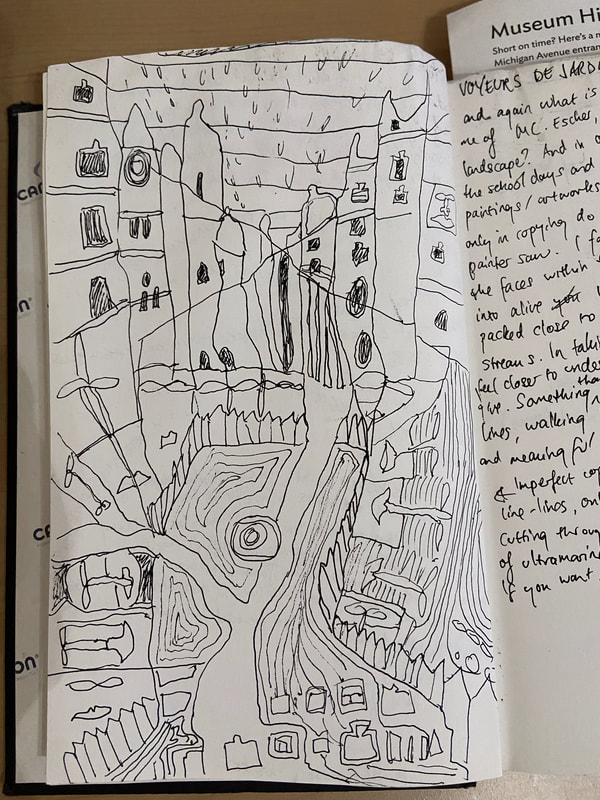

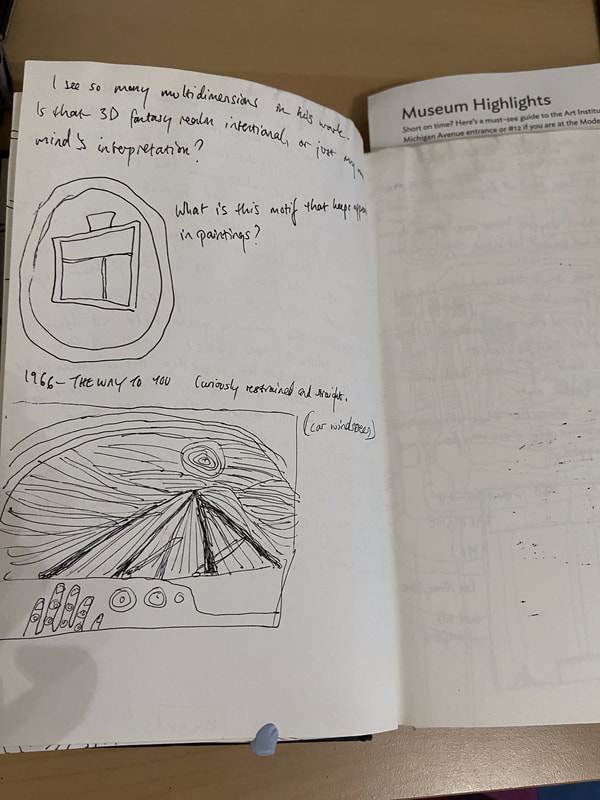
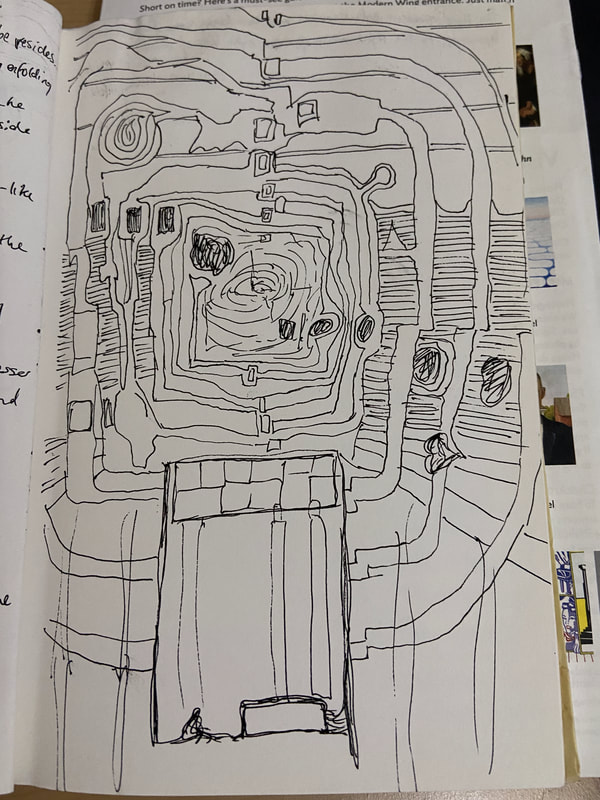


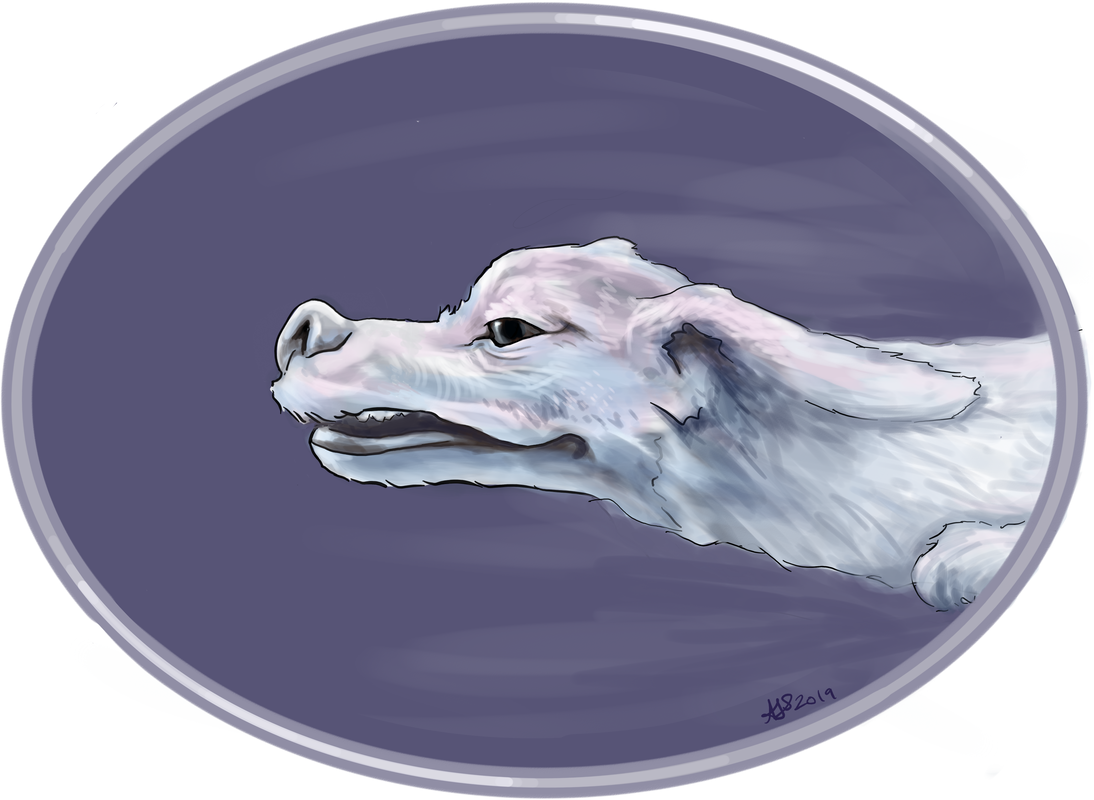



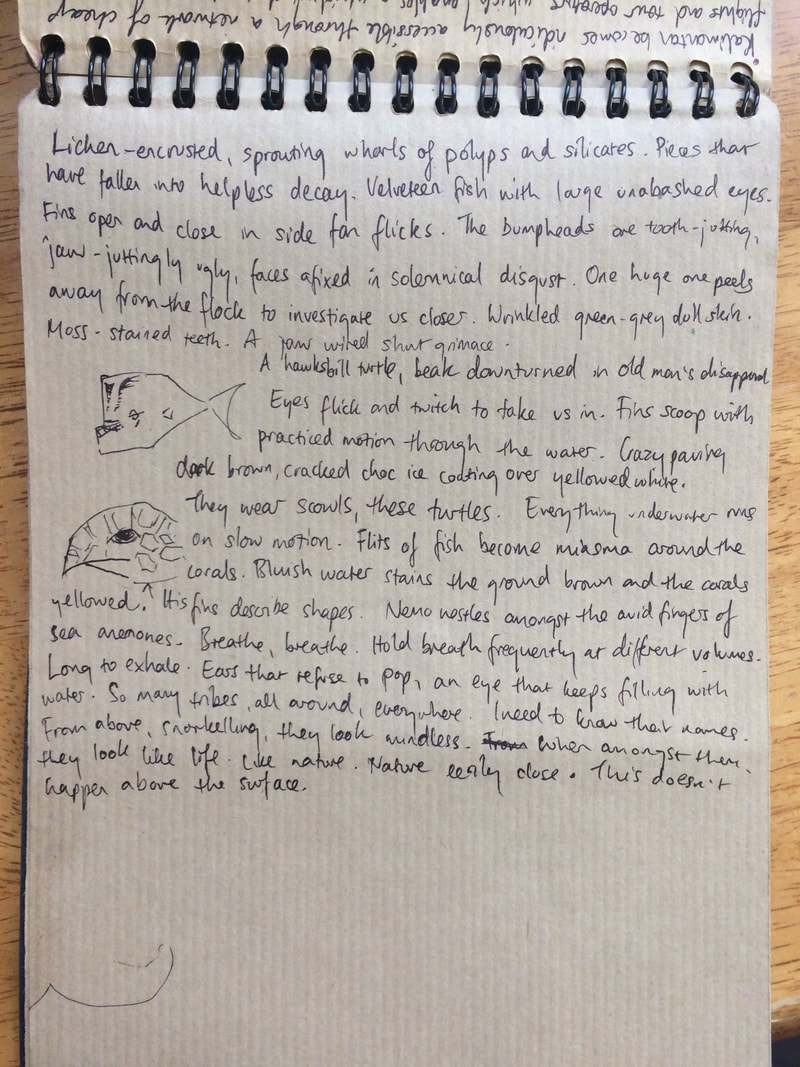
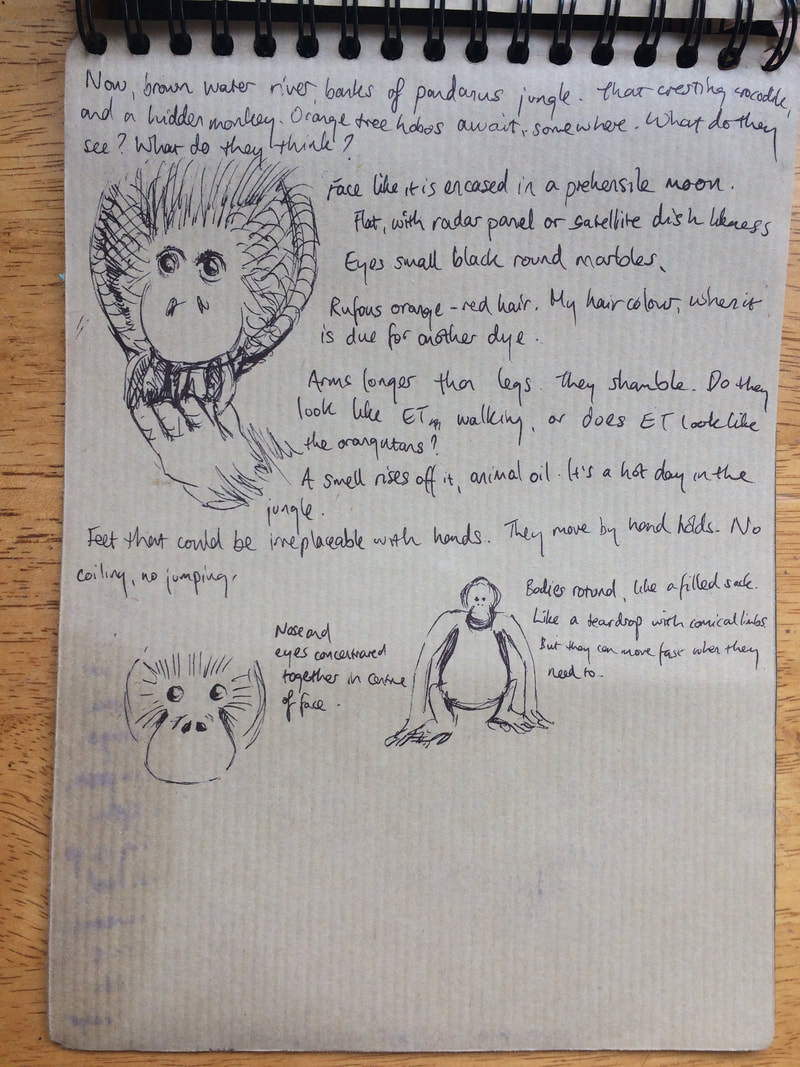
 RSS Feed
RSS Feed
